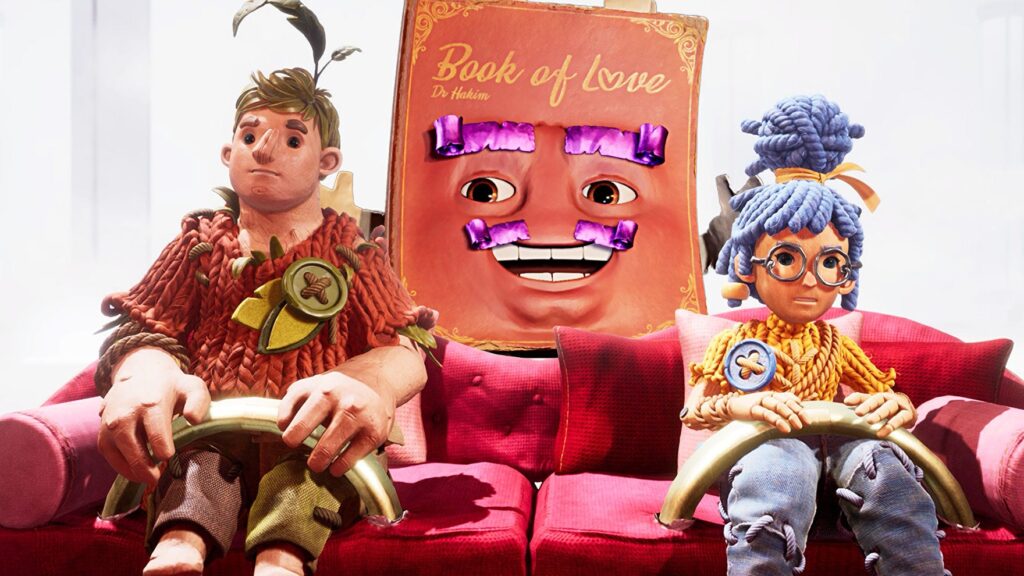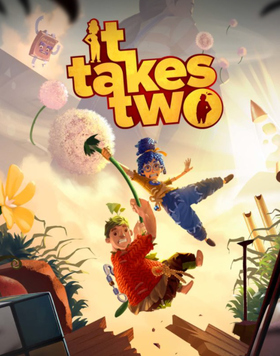My partner and I recently finished It Takes Two, the 2021 co-op puzzle-platformer from Hazelight Studios.
I’ve been thoroughly impressed by the co-op puzzles. They’re light enough to keep things moving—especially important in coop games where your players may have disparate skill levels and genre familiarity—but novel enough that some do occasionally offer some slow-down-and-think challenges.
The 3D platforming is very forgiving—probably on par with something like early levels in a 3D Mario game—and some of the jumps that seem like they’ll require precision skill turn out to have some gravity and “stickiness” that ends up being wildly generous. I do plenty of platforming, but my partner doesn’t and there’ve been no issues with platforming skill for either of us. The bosses can feel incongruously punishing at times, but because you only lose if both players die at the same time, we’ve been able to corpse-cannon most of them on the first attempt.
My only gripe is with game’s writing. While its settings, high-level premise, and enemies are charming and generally pretty cute, the central tension between the two main characters is nebulous at best. The main characters themselves are incredibly underspecified and it’s impossible to glean motivations from them—at one point they decide they need to make their daughter cry and then pursue this with a dogged intensity that is frankly baffling. Throughout the game, my partner and I wondered if this story was moving toward reconciliation because these characters didn’t show the telltale foreshadowing of internal reflection of any kind, and the writers did not seem to want us to like or root for these characters—much less the rekindling of their broken relationship—in any way for 90% of the game. But then again, we’d need to point to a more concrete problem in their marriage in order for that to work, and the game didn’t seem to want to commit to characterization or to reaching into anything other than a surface-level emotion or motivation at all. The lack of attention to the story is disappointing in a game that still uses the pacing model of cutscene-as-reward.

In some ways, the game feels like a AAA game from 15 years ago—not because of graphical fidelity, which is impressive, nor because of gameplay polish, which is generally excellent and staggaringly varied—but because of its structure (a straightforward linear mission structure with cutscenes as tools for pacing and level-completion payoffs), and because it manages to maintain a level of EA polish while still having retained some truly weird creative decisions. For example, the mechanism that serves to direct the player’s goals is an instruction-giving therapy book character who is incredibly ill-conceived to its core. My partner and I marvelled at how that character, with its line-skirting humor, and off-putting cariacatureness, managed to make it into a game of this scale and budget; it’s something you’d see in a AA game perhaps, or a game from a decade ago, but in a 2021 Game of the Year with this scale of budget? It’s unbelieveable. And while that book was one of my least-favorite parts of the game, I have to admit that it’s refreshing to play a AAA game that has some very weird “why in the world did this get made?” sorts of decisions. And despite being AAA, it doesn’t over-complicate its structure, doesn’t add unnecessary systems or features, and that doesn’t overstay its welcome. We finished the game in about 12 hours, which felt like the right length.
I’m glad games like this exist, and that at least as recently as 2021, we as an industry were still making them. The game is worth checking out for the co-op puzzles as long as you go in with very tempered expectations for the story.



